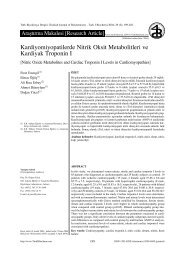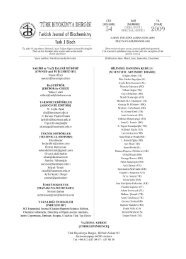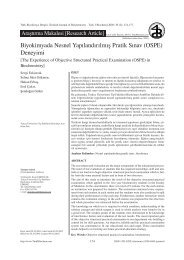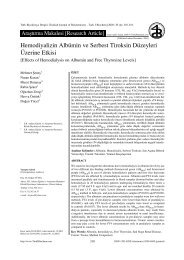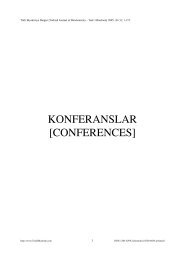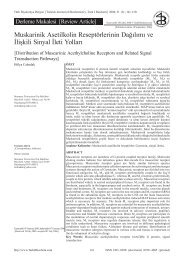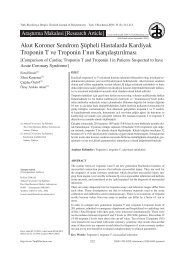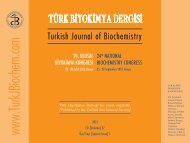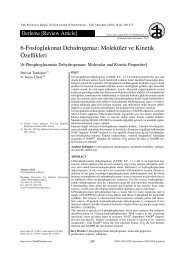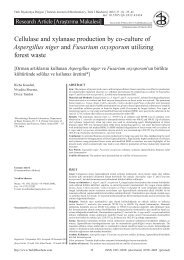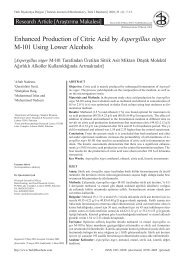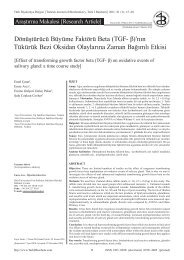23. Ulusal Biyokimya Kongresi Ãzel Sayısı - Türk Biyokimya Dergisi
23. Ulusal Biyokimya Kongresi Ãzel Sayısı - Türk Biyokimya Dergisi
23. Ulusal Biyokimya Kongresi Ãzel Sayısı - Türk Biyokimya Dergisi
Create successful ePaper yourself
Turn your PDF publications into a flip-book with our unique Google optimized e-Paper software.
XXIII. ULUSAL B‹YOK‹MYA KONGRES‹<br />
29 Kasım - 2 Aralık 2011<br />
Hilton Hotel - Adana<br />
<strong>23.</strong> <strong>Ulusal</strong> <strong>Biyokimya</strong> <strong>Kongresi</strong>, Adana [23 rd National Biochemistry Congress, Adana / TURKEY]<br />
İÇİNDEKİLER<br />
DAVETLİ KONUŞMACI ÖZETLERİ<br />
TALASEMİLİ HASTALARA HLA UYUMLU KARDEŞ SAĞLANMASI<br />
Mehmet Akif ÇÜRÜK<br />
Tıbbi <strong>Biyokimya</strong>, Tıp Fakültesi, Çukurova Üniversitesi, Adana.<br />
Beta talasemi, beta globin zincir sentezinin azalması veya kesin yokluğu sonucu<br />
hemolitik anemiye neden olan genetik bir hastalıktır. O iki mutant beta talasemi<br />
allelinin birlikte kalıtımı sonucu meydana gelmektedir. Hastalar kırmızı kan hücresi<br />
nakli ve organlarda aşırı demir birikimini önlemek için demir şelasyonu ile tedavi<br />
edilmektedir. HLA uyumlu donör kardeşten allojenik kordon kanı transplantasyonu<br />
beta talasemi hastası için mükemmel bir tedavi seçeneğidir. Çocuklarına genetik<br />
hastalığını geçirme riski yüksek olan çiftler fetusdaki genetik hastalığı belirlemeye<br />
uygun prenatal tanıya gitme seçeneğine sahiptir. Şayet analiz fetusun genetik olarak<br />
etkilendiğini gösterir ise tek seçenek gebeliği sonlandırmaktır. Son zamanlarda çiftlere<br />
sağlam fetus ile gebeliğe başlama şansını sağlayan preimplantasyon genetik tanı<br />
prenatal tanıya alternatif olmuştur. PGD tek gen mutasyonları ve HLA haplotipleri<br />
için embriyoyu analiz etme tekniğidir. PCR bu hastalıklar için tek hücre seviyesinde<br />
uygulanır. Tek gen hastalıklarının HLA uyumlu preimplantasyon genetik tanısı üreme<br />
tıbbının en son uygulamasıdır. Bu strateji, genetik hastalığını kalıtımla aktarma riski<br />
taşıyan bir çifte, talasemili çocuğuna HLA uyumlu sağlam bir embriyo seçmesi için<br />
bir araç olarak meydana çıkmıştır. Doğum esnasında, yenidoğan umbilikal kordon<br />
kanındaki hemopoetik kök hücreler hasta kardeşin tedavisi için kullanılmaktadır.<br />
Preimplantasyon embriyolarında HLA testi STR (short tandem repeat) analizleri ile<br />
rutin olarak yapılmaktadır.<br />
PRODUCING HLA-MATCHED SIBLING TO THALASSEMIC<br />
PATIENTS<br />
Mehmet Akif ÇÜRÜK<br />
Department of Medical Biochemistry, Faculty of Medicine, Çukurova<br />
University, Adana.<br />
Beta thalassemia is a genetic disorder resulting in absent or reduced beta globin chain<br />
synthesis producing hemolytic anemia. It results from co-inheritance of two mutant<br />
b-globin alleles. Patients are treated with red blood cell transfusions and iron chelation<br />
to prevent organ iron overload. Allogeneic cord blood cell transplantation from an HLAidentical<br />
sibling donor is an excellent treatment option for patient with b-thalassaemia.<br />
Couples at high risk of transmitting an inherited disease to their offspring have the<br />
option of undergoing prenatal diagnosis to allow the detection of the genetic disorder<br />
in the fetus. If the analysis reveals a genetically effected fetus, the only option is to<br />
terminate the affected pregnancy. Recently, preimplantation genetic dagnosis (PGD)<br />
is an alternative to prenatal diagnosis providing couples the chance to start a pregnancy<br />
with an unaffected fetus. This is a technique to analyze embryos for genetic mutations<br />
of single gene disorders and HLA haplotypes. For monogenic diseases, PCR is applied<br />
at the single-cell level. PGD of single gene disorders, combined with HLA matching,<br />
represents one of the most recent applications in reproductive medicine. This strategy<br />
has emerged as a tool for couples at risk of transmitting a genetic disease to select<br />
unaffected embryos of an HLA tissue type compatible with that of an existing affected<br />
child. At delivery, haematopoietic stem cells from the newborn umbilical cord blood<br />
are being used to treat the affected sibling. HLA testing on preimplantation embryos<br />
is now routinely performed by using STR analysis.<br />
CONTENTS<br />
ABSTRACTS OF INVITED LECTURES<br />
Turk J Biochem, 2011; 36 (S2)<br />
http://www.TurkJBiochem.com



